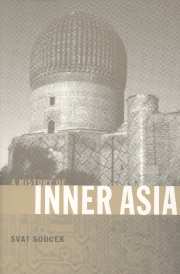Book contents
- Frontmatter
- Contents
- List of maps
- Preface
- Introduction
- 1 The beginnings
- 2 The Kök Turks, the Chinese expansion, and the Arab conquest
- 3 The Samanids
- 4 The Uighur kingdom of Qocho
- 5 The Qarakhanids
- 6 Seljukids and Ghaznavids
- 7 The conquering Mongols
- 8 The Chaghatayids
- 9 Timur and the Timurids
- 10 The last Timurids and the first Uzbeks
- 11 The Shaybanids
- 12 The rise of Russia, the fall of the Golden Horde, and the resilient Chaghatayids
- 13 The Buddhist Mongols
- 14 Bukhara, Khiva, and Khoqand in the seventeenth to nineteenth centuries
- 15 The Russian conquest and rule of Central Asia
- 16 From Governorates-General to Union Republics
- 17 Soviet Central Asia
- 18 Central Asia becomes independent
- 19 Sinkiang as part of China
- 20 Independent Central Asian Republics
- 21 The Republic of Mongolia
- Summary and conclusion
- Appendix 1 Dynastic tables
- Appendix 2 Country data
- Select bibliography
- Index
19 - Sinkiang as part of China
Published online by Cambridge University Press: 05 June 2012
- Frontmatter
- Contents
- List of maps
- Preface
- Introduction
- 1 The beginnings
- 2 The Kök Turks, the Chinese expansion, and the Arab conquest
- 3 The Samanids
- 4 The Uighur kingdom of Qocho
- 5 The Qarakhanids
- 6 Seljukids and Ghaznavids
- 7 The conquering Mongols
- 8 The Chaghatayids
- 9 Timur and the Timurids
- 10 The last Timurids and the first Uzbeks
- 11 The Shaybanids
- 12 The rise of Russia, the fall of the Golden Horde, and the resilient Chaghatayids
- 13 The Buddhist Mongols
- 14 Bukhara, Khiva, and Khoqand in the seventeenth to nineteenth centuries
- 15 The Russian conquest and rule of Central Asia
- 16 From Governorates-General to Union Republics
- 17 Soviet Central Asia
- 18 Central Asia becomes independent
- 19 Sinkiang as part of China
- 20 Independent Central Asian Republics
- 21 The Republic of Mongolia
- Summary and conclusion
- Appendix 1 Dynastic tables
- Appendix 2 Country data
- Select bibliography
- Index
Summary
Sinkiang came under Chinese rule, as we have seen, in 1758 with the defeat of the Jungar Mongols. The arrangement was analogous to that with Outer Mongolia, for the region became a possession of the Manchu Dynasty rather than being integrated into the empire as one more province. This had two important effects: the native population, mostly Muslim and Turkic-speaking after the virtual extermination of the Mongol population in Jungaria, retained a considerable degree of self-rule at all but the highest levels, and no immigration from China proper was allowed.
The Manchus followed the natural configuration of the conquered territory by dividing its administration into Pei Lu and Nan Lu, the aforementioned division of the province into a northern and southern segment. The amban or lieutenant-governor of the former resided at Urumchi, that of the latter at Yarkand; both halves were under the governor-general whose residence, Kulja (Yi-ning or Ining in Chinese), was founded by the Manchus near the remnants of the historic city of Almaliq on the Ili river. Peace and prosperity marked the first decades of this benign colonial rule, and in fact continued for over a century despite increasing flare-ups of native unrest in Nan Lu, often fomented by spiritual or relational descendants of seventeenth-century Khwajas (events of 1825, 1830, 1846, and 1857). These disturbances received some support from the khanate of Khoqand, whose rulers, although on occasion opportunely recognizing a vague form of Chinese suzerainty, obtained special privileges in western Sinkiang all the way to the river and city of Aksu: trading advantages for its merchants and even the right to collect certain taxes were among these.
- Type
- Chapter
- Information
- A History of Inner Asia , pp. 263 - 274Publisher: Cambridge University PressPrint publication year: 2000



